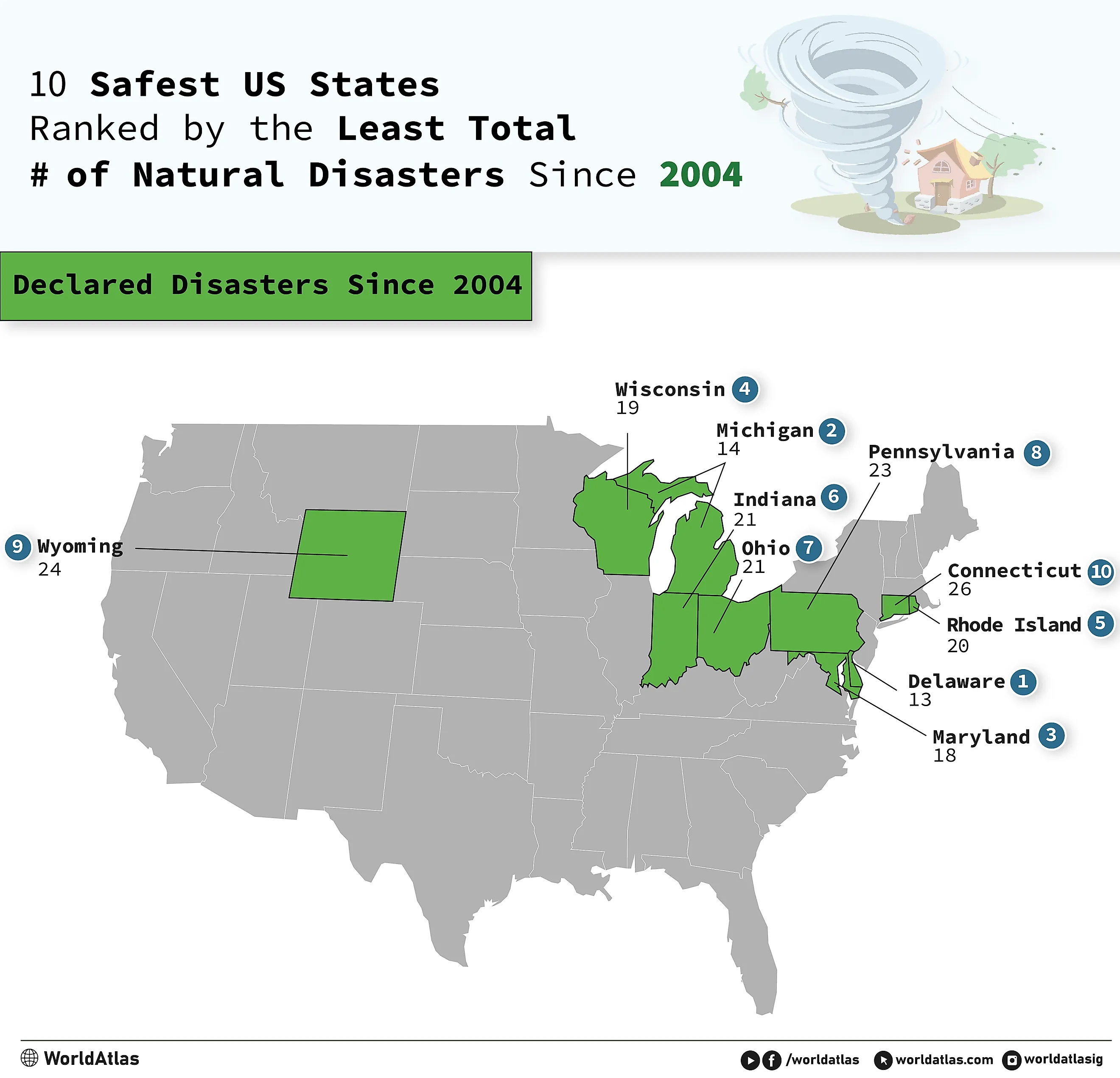
10 Safest States From Natural Disasters
It turns out lightning can and will strike the same place twice. When it comes to a country as geographically wild as the United States, natural disasters occur with varying frequency and ferocity. California is the most dangerous state, considering it has witnessed 272 declarations of disaster in the past 20 years, according to FEMA. Delaware is arguably the safest state in the United States, with just 13 occurrences of natural disaster since 2004, with Michigan and Maryland closely behind at 14 and 18 incidences, respectively.
Different approaches to analyzing this data are possible, such as differentiating natural versus artificial disasters and weighing the size of the state's land area. However, whether or not anyone is around to hear a tree fall in the forest, it will still fall. Therefore, these ten safest states are ranked by the least number of natural disasters during the most recent two decades.
The 10 Safest States Ranked By Least Total Natural Disasters Since 2004
| Rank | State | Declared Disasters Since 2004 |
|---|---|---|
| 1 | Delaware | 13 |
| 2 | Michigan | 14 |
| 3 | Maryland | 18 |
| 4 | Wisconsin | 19 |
| 5 | Rhode Island | 20 |
| 6 | Indiana | 21 |
| 7 | Ohio | 21 |
| 8 | Pennsylvania | 23 |
| 9 | Wyoming | 24 |
| 10 | Connecticut | 26 |
Click here to view: All 50 Safest States Ranked By Least Total Disasters Since 2004
1. Delaware

Despite being occasionally subject to the wrath of Nor'easters (Atlantic Cyclones), Delaware has managed to claim the title of the state safest from natural disasters. That record is upheld by the fact that since 2004, only 13 emergency declarations have occurred in the state, compared to the national average of just over 50. Flash flooding, tornadoes, thunderstorms, and hail do occur rarely, with one tornado warning being issued in the wake of Hurricane Jeane in 2004. The majority of other incidents occurred several years apart as a result of northward-bound hurricanes and tropical storms. Ultimately, there are two factors that make Delaware one of the safest states in the US from natural disasters: the infrequency and mildness of possible events and the fact that Delaware ranks highly in emergency health preparedness, according to a 2009 study by the University of Delaware.
2. Michigan
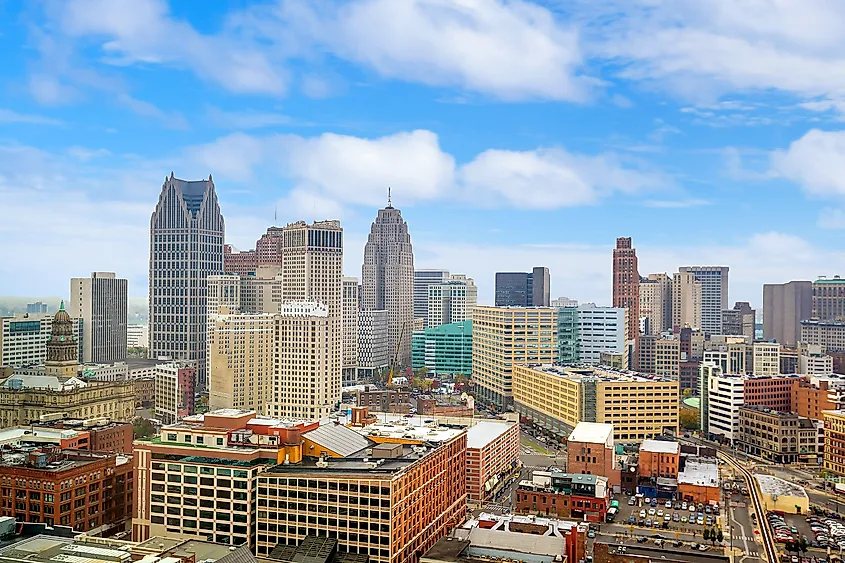
Michigan and other Great Lake states are tremendously safe for several reasons. This safety is a reality in spite of the fact that this ranking solely considers the total amount of disasters; large states like Michigan seem as though they ought to rank worse by virtue of having more land for disasters to occur in, yet this is not always the case. The Great Lakes themselves offer a form of protection by regulating the surrounding air temperature, which prevents the formation of severe storms. Seismic issues like earthquakes are also not a significant threat, as the state lies far from any violently active fault lines. Michigan also has no ocean coastline, which by default means that hurricanes and cyclones are weakened by the time they arrive that far inland.
3. Maryland
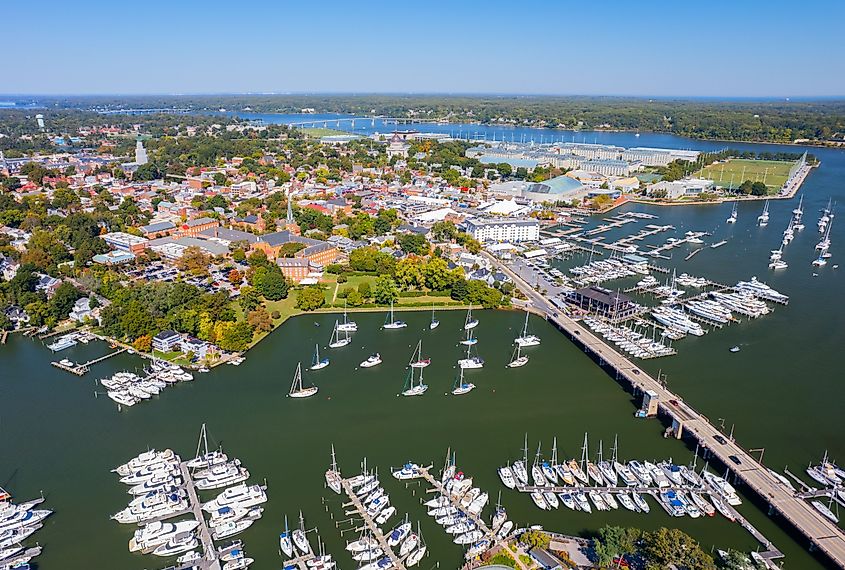
In general, the Mid-Atlantic region is spared the extremes that North America is at the mercy of elsewhere. Maryland, like Michigan, is relatively far away from fault lines that could bring about devastating tremors and volcanic eruptions (which are only significant in Hawaii, Alaska, and a few states out west). Tornadoes can and do occur on the East Coast, which is why Maryland handled a tornado declaration in 2006, but the severity and frequency are negligible compared to Tornado Alley states in the Midwest. At less than one emergency declaration per year in the last 20 years, Maryland is able to regularly avoid nature's wrath despite having only an average emergency response infrastructure, according to one ranking by Gold Eagle.
4. Wisconsin
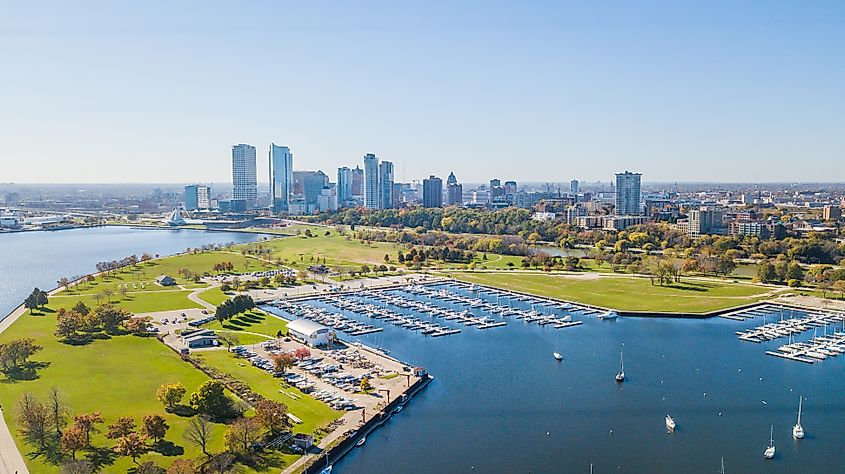
Wisconsin is known for its rolling hills and gentle lakefronts, and these environments are able to exist because of a network of safeguards working in tandem. A healthy climate, neither too dry nor too stormy, thanks to the Great Lakes, guarantees a spread of grasslands and forests despite the plains and deserts of states farther to the south. Rooted soils in a humid environment are naturally more resilient to flash floods, wildfires, and mudslides. So, in the 19 disasters since 2004, Wisconsin has only been challenged by four landslide and mudslide events that occurred during unusually strong storms between 2013 and 2019. Storms and floodings, without large movements of the earth, are more typical. Late spring to fall is also the peak months for these events, but the largest risks are for those living on floodplains, such as the suburbs of Milwaukee. Technically, modern infrastructure is consistently designed around the presumption of such disasters, but it never hurts to educate oneself on preparation and evacuation.
5. Rhode Island
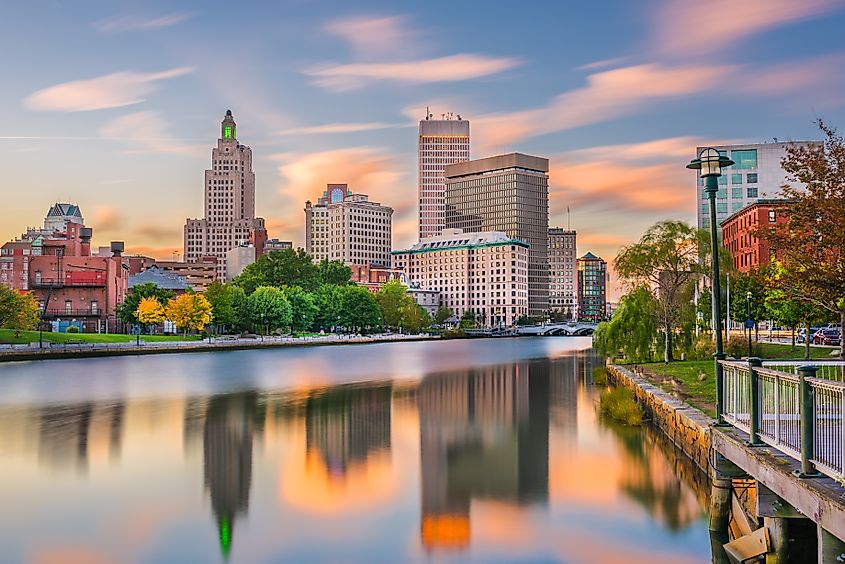
Although it is another state exposed to the whimsy of Atlantic storms and northern snowfall, Rhode Island is still a remarkably stable slice of land. For instance, the only major fire that occurred in the last 20 years was due to a campsite in 2023, which is arguably more artificial than it is natural. Furthermore, the Fire Team's response was strong and effective enough that no injuries or fatalities were reported. Wielding infrastructure effectively is a much simpler task as Rhode Island is the smallest US state, and much of that infrastructure looks like coastal protection measures and flood management systems for defense against hurricanes. As hurricanes work their way up the coast, after typically being generated southeast toward Florida, that energy gradually dissipates. Rhode Island is fairly northward, which means that it does not take the full force of such storms (aside from the occasional Nor'easter cyclone).
6. Indiana
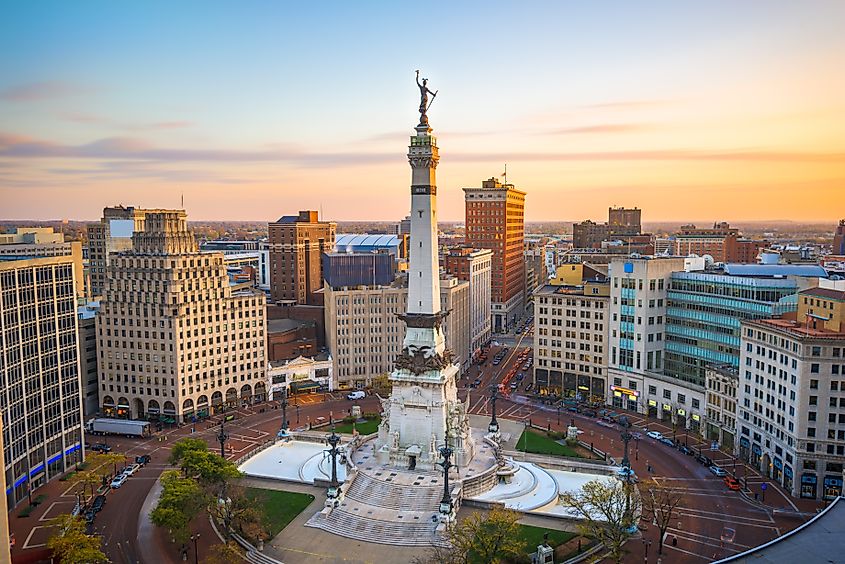
For the first time in 11 years, a tornado caused fatalities in Indiana after EF-3 winds struck in 2023. As jarring as that event was, Indiana is not typically prone to disaster. Extreme natural features are not commonplace, and the mountains, large rivers, and fault lines to the southwest have mild impacts. Meanwhile, floods and storms, including the snowy variety, do make an appearance roughly every other year but do not leave irreparable wakes of destruction. The most likely disturbance to the state can come in the form of heat waves or rare ice storms, which cut off power by knocking down electric lines. Despite the irregularity of a cataclysmic event, tornado warnings are common across Indiana, so vigilance is strongly recommended.
7. Ohio
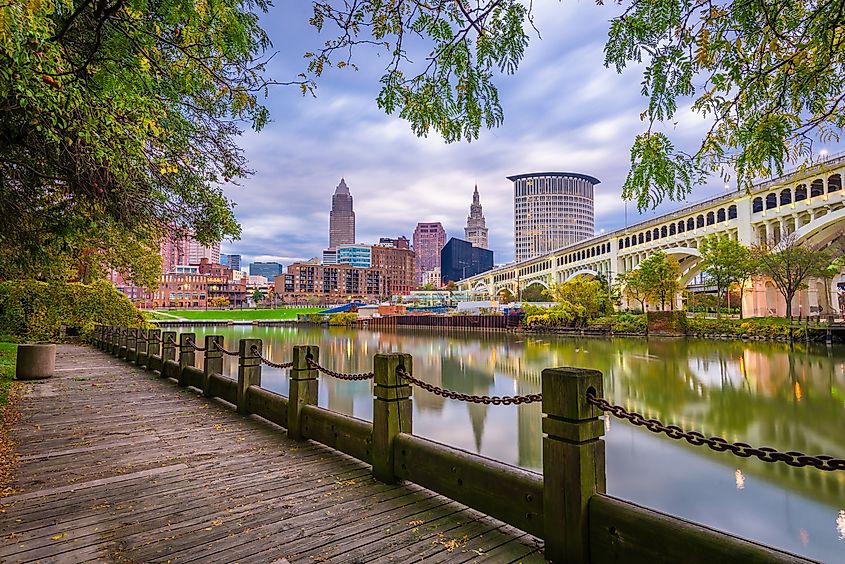
Ohio lies to the east of Indiana, and thus, it also benefits from the protection of the Great Lakes, distance from tornado alley, seismic activity, and Atlantic hazards. However, like Indiana, it has also received 21 disaster declarations since 2004. Fierce winter weather, tornado and flooding events, and landslides make up the bulk of these disasters. Hurricane Sandy punched its way inland enough in 2012 to batter northeast Ohio because few trees or buildings were present to reduce the wind speeds. Although these disasters are presented back to back, it is important to continue remembering that significant events, such as these in Ohio, are spread apart with around a year in between on average. This rate is significantly less than the national average of 2.5 disasters/year or California's 13.6 disasters/year.
8. Pennsylvania
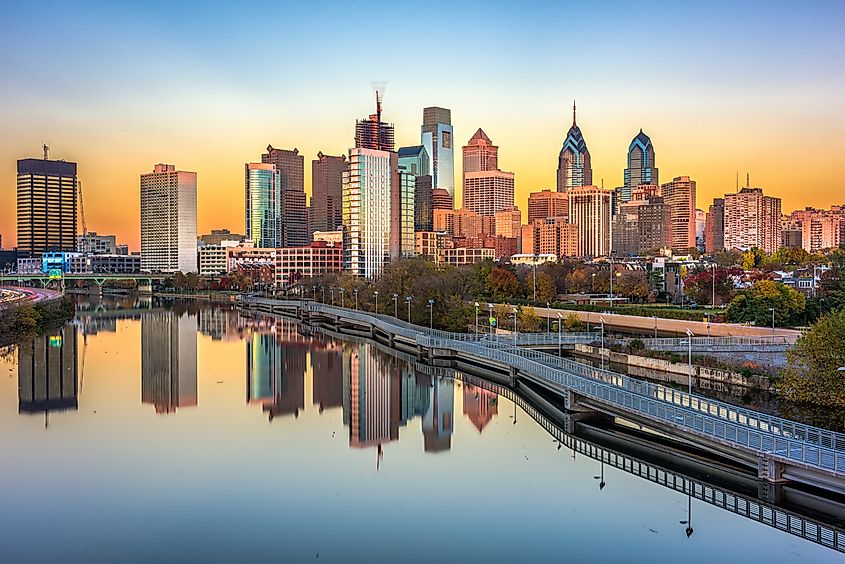
Unlike Ohio, Pennsylvania benefits from mountains and valleys that work to control flooding, and they also shield Pennsylvania's inland regions from direct hits by hurricane winds. Despite that advantage, severe storms and flooding are abundantly frequent disasters that occur at least once a year. Historically, Pennsylvania's worst disaster occurred in 1889: the Johnstown Flood claimed over 2,200 lives after a dam ruptured during excessive rainfall. Thankfully, engineering techniques have improved in the last century, so a rupture of this magnitude is exponentially less likely today.
9. Wyoming
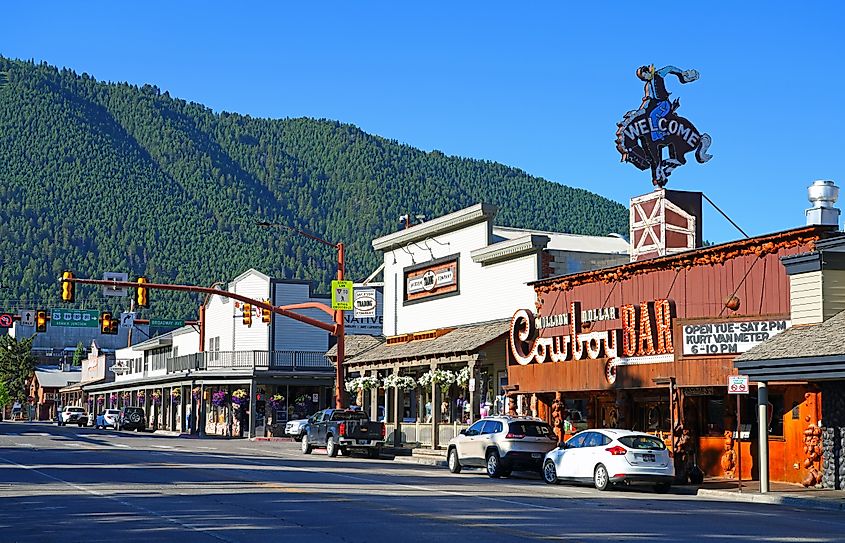
While the west tends to be more perilous thanks to fault lines, mountains, deserts, and tornadoes, Wyoming manages to stay in the top ten safest states. Interestingly, as opposed to flooding and storms (which still made up nearly a fifth of the disasters since 2004), Wyoming is inundated with fire risks. The reason flooding happens significantly less in Wyoming is because the climate is semi-arid, and by definition, a drier and windier environment has less water to distribute; therefore, fire is more common. However, even though rainfall can be infrequent in arid environments, flash floods are devastating when they occur, such as in states like Arizona and Nevada. A singular tornado threat occurred in 2005, but those events are either rare or significantly less reported.
10. Connecticut

Connecticut is a practical conclusion to this top ten ranking because it summarizes the experience of many East Coast communities: tropical storms and hurricanes are unforgiving, even if the rate of those disasters is spread out over the years and remains less than the national average. Hurricane Ida, Sandy, Irene, Henri, and tropical storm Isaias have all taken a toll on this New England state. Of course, the severity is dampened by Connecticut's location, and damaging earthquakes and wildfires are extremely rare. Seven of the 26 disasters in the last 20 years were related to snowfall and snowstorms; remember, the cold can be deadly. Moreover, fatal vehicle crashes related to these conditions occurred in Connecticut in 2011, 2013, and several other recent years.
Final Thoughts
It should be noted that although FEMA considers the COVID-19 pandemic a declared emergency, and indeed, each of the 50 states reported it, the topic was not touched on here because it lies in a gray area between natural and artificial disasters. Earthquakes, volcanoes, tornadoes, hurricanes, and many other dangers are readily available through the USA as-is, and while these ten states experience less of each, no region is impervious from the Earth's forces. Thus, no matter where you reside, it is always best to have your own plan to prepare for all kinds of natural disasters and keep yourself safe.
All Safest States Ranked By Least Total Disasters Since 2004
| Rank | State | Declared Disasters Since 2004 |
|---|---|---|
| 1 | Delaware | 13 |
| ** | District of Columbia | 14 |
| 2 | Michigan | 14 |
| 3 | Maryland | 18 |
| 4 | Wisconsin | 19 |
| 5 | Rhode Island | 20 |
| 6 | Indiana | 21 |
| 7 | Ohio | 21 |
| 8 | Pennsylvania | 23 |
| 9 | Wyoming | 24 |
| 10 | Connecticut | 26 |
| 11 | Illinois | 26 |
| 12 | South Carolina | 27 |
| 13 | New Jersey | 30 |
| 14 | Virginia | 30 |
| 15 | Minnesota | 32 |
| 16 | Idaho | 33 |
| 17 | Massachusetts | 34 |
| 18 | Vermont | 35 |
| 19 | North Carolina | 36 |
| 20 | North Dakota | 37 |
| 21 | Arkansas | 39 |
| 22 | Georgia | 39 |
| 23 | Maine | 39 |
| 24 | West Virginia | 39 |
| 25 | Hawaii | 41 |
| 26 | Iowa | 41 |
| 27 | Kentucky | 41 |
| 28 | New Hampshire | 41 |
| 29 | Utah | 41 |
| 30 | Alabama | 43 |
| 31 | Missouri | 43 |
| 32 | Mississippi | 46 |
| 33 | Tennessee | 47 |
| 34 | Alaska | 50 |
| 35 | Nebraska | 50 |
| 36 | New York | 50 |
| 37 | Colorado | 51 |
| 38 | Louisiana | 55 |
| 39 | South Dakota | 55 |
| 40 | Montana | 57 |
| 41 | Kansas | 58 |
| 42 | Nevada | 61 |
| 43 | Arizona | 66 |
| 44 | Florida | 72 |
| 45 | New Mexico | 73 |
| 46 | Oregon | 86 |
| 47 | Washington | 130 |
| 48 | Oklahoma | 164 |
| 49 | Texas | 176 |
| 50 | California | 272 |











